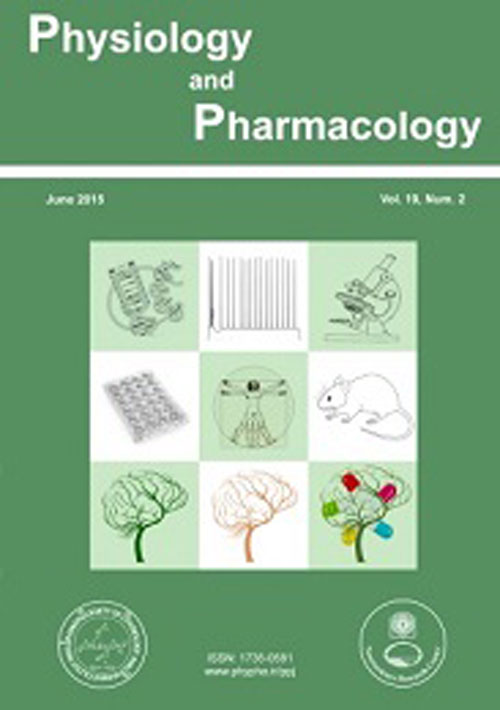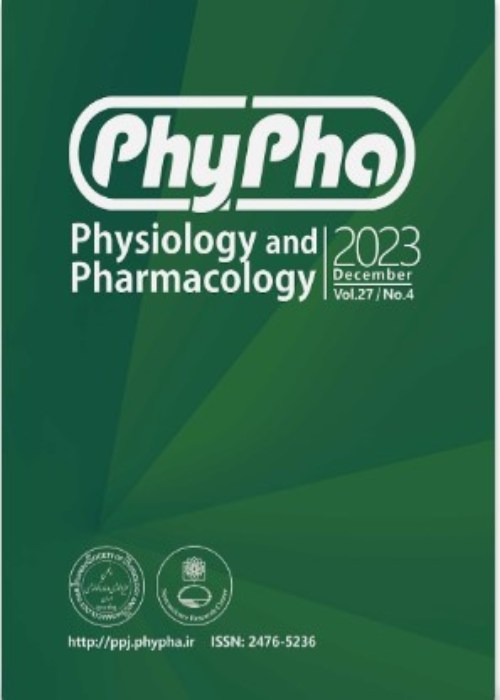فهرست مطالب

Physiology and Pharmacology
Volume:19 Issue: 3, Sep 2015
- تاریخ انتشار: 1394/10/12
- تعداد عناوین: 8
-
-
Pages 146-157Ischemic brain injury involves a complex sequence of excitetoxic and oxidative events. Metformin is proposed as one of the potential candidates for returning the body to its basic homeostasis in ischemic situations. Metformin can either protect or damage cells by activating AMP-activated protein kinase (AMPK) and its downstream factors; so, it has a dual role in the cerebral ischemia context, but more investigations are needed to define its exact underlying mechanism. Herein, we classify the controversial results of metformin therapy in the experimental models of brain ischemia; central and peripheral injection of metformin, chronic and acute treatment, pre- and post-treatment with metformin, tissue-specific role of metformin, dose-specific effect of metformin, age-dependent aspects of metformin therapy. Categorizing different types of cerebral ischemia is important in investigating the dual role of metformin. Due to the variations in metformin therapy, it can be used for chronic treatment, but the patients must be informed about its harmful effects. Although the mechanisms in which AMPK protects/degenerates neurons against ischemic stress situation are still unknown.Keywords: Metformin, AMPK, Glucose, Brain, Ischemia
-
Pages 158-166IntroductionOne of the main mechanisms by which diabetic complications occur is an alteration of the structure and function of proteins due to hyperglycemia. Aspirin (ASA) affects cellular pathways through different mechanisms, including glycation inhibition and antioxidant activity. The aim of the present study, as a follow up to our previous one, is to investigate the effect of long-term, high-dose ASA therapy on mitochondrial respiratory chain complexes in the kidneys and brain of streptozotocin-induced diabetic rats. Its effect on liver toxicity of the rats was also investigated.Materials And MethodsHigh dose of ASA (100 mg/kg in drinking water) was administered to streptozotocin-induced diabetic rats during the twelve-week study period. After that, the rats were sacrificed under anesthesia and the tissues were retained -80 °C. Then the activity of respiratory chain complexes and the mentioned enzyme were measured in the brain, kidney, liver and serum of rats.ResultsTreatment of diabetic rats with ASA could significantly compensate for the decreased activity of complex III respiratory chain in the kidneys. In addition, the activity of the liver enzymes (ALT, AST, ALP and LDH) in the serum of diabetic rats was significantly reduced by administration of ASA. However, there were no other significant functional changes observed in the kidney and brain respiratory chains complexes and the mentioned enzymes in liver.ConclusionIn conclusion, ASA therapy has a beneficial effect on the mitochondrial complexes and some serum enzymes in diabetic rats.Keywords: Aspirin, Streptozotocin, Respiratory Chain Complex, Brain, Kidney, Liver Enzymes
-
Pages 167-176IntroductionCarbon nanotubes (CNTs) have shown enormous potential in neuroscience. Nerve growth factor (NGF)-CNTs complex promotes the neuronal growth, however, the underlying mechanism(s) have remained elusive. Based on the interplay between NGF and the endocannabinoid system, involvement of the neuroprotective endocannabinoid, 2-arachidonoyl glycerol (2-AG), was investigated in the mechanism of action of NGF.Materials And MethodsMulti-walled CNTs (MWCNTs)-NGF complex was prepared using amino-functionalized COOH-MWCNTs. MWCNTs were characterized by Fourier transform infrared (FTIR) spectroscopy and scanning electron microscopy (SEM). In vitro cytotoxicity was evaluated by MTT assay. Following three times daily intracerebroventricular injections of NGF solution (2, 5, and 10 μg), and 5, 10, and 20 μg of acid- or amine-modified MWCNTs, or MWCNTs-NGF complex for either one or 7 days, 2-AG contents were quantified in the frontal cortex and hippocampus of rats by isotope-dilution liquid chromatography/mass spectrometry.ResultsFTIR confirmed the amino-functionalization of COOH-MWCNTs and NGF immobilization on the aminated MWCNTs. Aminated MWCNTs and MWCNTs-NGF complex showed less cytotoxicity than COOH-MWCNTs (P<0.05, P<0.01, and P<0.01). Chronic, but not acute, administration of MWCNTs-NGF complex and NGF solution at the highest dose tested led to the elevation of 2-AG at 1 h from the last injection (P<0.01 and P<0.001). 2-AG enhancement induced by MWCNTs-NGF complex lasted for up to 5 and 12 h post-injection (P<0.01 and P<0.001). 2-AG contents remained at the baseline level in the sham and groups receiving vehicle, acid- or amine-modified MWCNTs (P>0.05).ConclusionFunctionalized MWCNTs-NGF complex induces a long-lasting increase of brain 2-AG content indicating the efficiency of this nanostructure to provide a sustained concentration of NGF. Implication of 2-AG in the mechanism of action of NGF might be of great therapeutic significance in the neurological disorders.Keywords: Carbon nanotubes, Nerve growth factor, Endocannabinoid signaling
-
Pages 177-184IntroductionGap junctions are specialized cell–cell contacts between eukaryotic cells through which they communicate. This type of communication has the potential to modulate memory process. We evaluated the effects of the gating of the hippocampal CA1 area gap junction channels on memory consolidation, using passive avoidance task.Materials And Methods72 adult male Wistar rats were distributed into 9 groups of 8 each. Two guiding cannulas were bilaterally implanted in the hippocampal CA1 area of all rats. One week after surgery, the animals received an electrical shock with the intensity and duration of 0.3 mA and 1s, respectively. Immediately after training 25, 75 or 150 nM doses of carbenoxolone, a non-selective blocker of gap junction channels or 50, 150 and 1500 nM doses of trimethylamine, an opener of gap junction channels were injected. Another group received 50 nM trimethylamine and 10 min later 75 nM carbenoxolone, immediately post-training. 24 hours later, memory retrieval was assessed.ResultsPost-training injection of carbenoxolone significantly and dose- dependently decreased step-through latency, whereas post-training injection of trimethylamine showed a tendency toward increasing step-through latency. Post-training injection of trimethylamine (50 nM) increased step-through latency, significantly compared with post-training injection of carbenoxolone (75 nM and 150 nM). Post-training injection of trimethylamine (50 nM) before carbenoxolone (75 nM) reversed the effects of carbenoxolone on inhibition of memory consolidation.ConclusionThese data suggest that the intercellular coupling via gap junction channels in the hippocampal CA1 cells is crucial for memory consolidation in the passive avoidance task.Keywords: Gap junction, Memory, Hippocampal CA1 area, Passive avoidance task
-
Pages 185-192IntroductionAlthough the initial hypothesis for the action of doxepin was based on the inhibition of the reuptake of neurotransmitters, it has been suggested that it may also involve other mechanisms. Therefore, this study aims to investigate the effect of doxepin on spatial memory, tumor necrosis factor alpha (TNF-α) level, expression of pro-apoptotic (Bad and Bax) and anti-apoptotic (Bcl-2) genes in the rat hippocampus.Materials And MethodsMale rats were divided randomly into three groups; the control, the doxepin 1 and 5 mg/kg, respectively). Rats received i.p injection of doxepin for 21 days. Spatial memory was evaluated by Morris water maze test. Then the hippocampi were dissected for measurement of the expression of Bcl2, Bad and Bax genes and the TNF-α level.ResultsOur results showed no significant effects of doxepin on spatial memory. Doxepin significantly decreased expression of Bad gene, but had no significant/considerable effects on Bcl2 and Bax gene expression. Also, the ratio of TNF-α to total protein (%) did not show significant differences in the rat hippocampus.ConclusionThese results did not show any significant impact of doxepin on the factors affecting the neuronal functions in intact animals. However, Since a significant reduction in the hippocampal Bad mRNA levels was observed It is our assumption that doxepin has neuroprotective effects.Keywords: Doxepin, Memory, Hippocampus, Bcl, 2 family, TNF, α.
-
Pages 193-199IntroductionOpium addiction can change immune response to Types of stress such as injury or trauma due to alterations in the in secretion status of cytokines in the body. In this study, effects of opium addiction on wound healing and post-operative adhesion bands were assessed after laparotomy.Materials And MethodsMale rats (n=20) were randomly divided into opium addicted (documented with Naloxone test) and control group. Three weeks after surgery, site of abdominal incision was excised elliptically and sent for wound healing grading assessment by pathologist and an intra-abdominal adhesion band assessment was done. The concentrations of three cytokines (TNF, IFN and IL10) were also measured before, immediately after surgery and 24 hour after surgery.ResultsPost-operative intra-abdominal adhesion was decreased in opium addicted group in comparison to control group (p value = 0.014). No statistically significant difference was found in the wound healing phase in two groups (P value = 0.057). Our findings showed that serum level of TNF, IFN and IL10 in two groups measured in all phases of examination (before surgery, within 30-60 min after surgery and 24h after surgery), were not statistically different/significant (p>0.05).ConclusionSince opium addiction can decrease post-operative intra-abdominal adhesions in rats, they may be susceptible to increased inflammation and these effects may be due to decreased post-operative pain.Keywords: Opium Addiction, Laparotomy, Wound healing, Adhesion, Rats
-
Pages 200-207IntroductionObesity and visceral fat accumulation after menopause are associated with insulin resistance and cardiovascular diseases. We investigated the interactive effect of aerobic-resistance training and estrogen replacement therapy on visceral fat, omentin-1 and HOMA-IR in ovariectomized rats.Materials And MethodsFifty female Wistar rats were ovariectomized (OVX) and divided into 5 groups (n=10 rats per group): Ovx+sedentary (Sedentary), aerobic-resistance training (Ovx+Exe), aerobic-resistance training+estrogen replacement therapy (Ovx+Exe+Est), estrogen replacement therapy (Ovx+Est) and sesame oil (Ovx+Oil). The exercise consisted of 8-week aerobic-resistance training (20 m/min, 3 days/week, 60 min/day, 10% slope, Load; 3% body weight).17b-estradiol valerate (30 μg/kg bw; in 0.2 ml sesame oil) were injected subcutaneously, three days a week during 8 weeks; and the Ovx+Est+Est received both exercise protocol and estradiol as previous groups. Obtained data were analyzed by ANOVA and post hoc Tukey test.ResultsOmentin-1showed significant increase in Ovx+Exe compared to Ovx+Exe+Est and Ovx+Est (P<0.05). HOMA-IR and visceral fat was decreased in Ovx+Exe, Ovx+Exe+Est compared to Sedentary (P<0.05).ConclusionEight-week aerobic-resistance training, 17-b estradiol replacement and co-treatment of exercise+estrogen successfully decreased visceral fat and insulin resistance probably via elevation in omentin-1 in ovaryectomized rats. Regarding the risk of hormone replacement therapy this study suggests that 2- month aerobic-resistance training is more effective in treating metabolic syndrome, rather than estrogen replacement therapy.Keywords: Combined Exercise, Hormone Therapy, HOMA, IR, Omentin, 1, Visceral Adipose
-
Pages 208-216IntroductionBusulfan as a chemotherapeutic agent causes testicular germinal epithelium depletion and cytotoxicity in germ cells. The aim of this study was to assess antioxidant status, reactive oxygen species (ROS) generation and apoptosis-related genetic markers of adult male mouse sperm following busulfan treatment.Materials And MethodsForty adult NMRI mice (30 ± 5 g) were divided into two groups. Control and busulfan treated group were administered with 100 μL dimethyl sulfoxide and 3.2 mg/kg/day busulfan for 4 days, respectively. The superoxide dismutase and glutathione peroxidase assays were used for analyzing antioxidant status. Then, the levels of Bcl-2 family gene expression, lipid peroxidation and cytotoxicity were evaluated by Real-Time PCR, thiobarbituric and lactate dehydrogenase assays, respectively.ResultsThe results showed significant decrease on antioxidant status, increase on lipid peroxidation and lactate dehydrogenase in epididymal sperm and testis of busulfan treated mice in comparison with control (P< 0.05). Real Time PCR demonstrated significantly increased-Bax gene expression and decreased-Bcl-2 gene expression in epididymal sperm of treated group (P< 0.05).ConclusionThe high levels of lipid peroxidation and lactate dehydrogenase revealed increased-ROS and severe cytotoxicity in epididymal sperm and testis tissue following busulfan treatment at clinical dose. The oxidative stress and increased-ROS may induce Bcl-2 family gene expression-related apoptosis following busulfan therapy in normal cells.Keywords: Apoptosis, Bcl, 2 family genes, Busulfan, Epididymal sperm, Oxidative stress.


